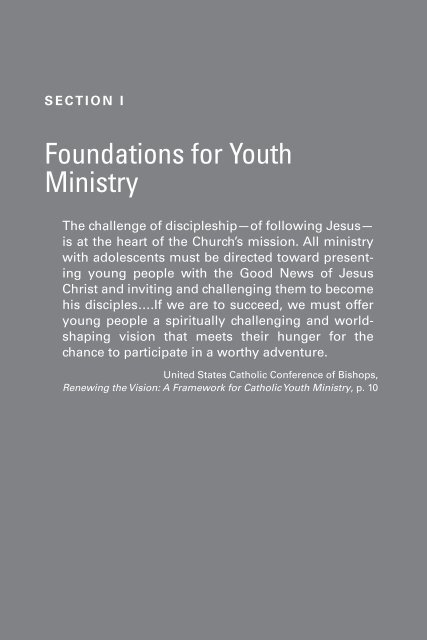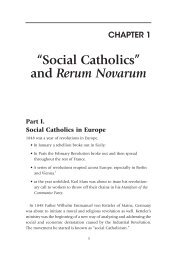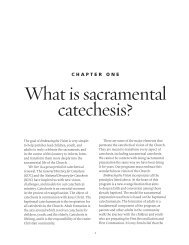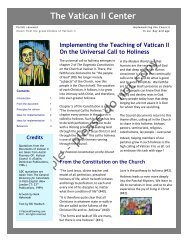Foundations for Youth Ministry - Pastoral Planning
Foundations for Youth Ministry - Pastoral Planning
Foundations for Youth Ministry - Pastoral Planning
You also want an ePaper? Increase the reach of your titles
YUMPU automatically turns print PDFs into web optimized ePapers that Google loves.
Section I<br />
<strong>Foundations</strong> <strong>for</strong> <strong>Youth</strong><br />
<strong>Ministry</strong><br />
The challenge of discipleship—of following Jesus—<br />
is at the heart of the Church’s mission. All ministry<br />
with adolescents must be directed toward presenting<br />
young people with the Good News of Jesus<br />
Christ and inviting and challenging them to become<br />
his disciples….If we are to succeed, we must offer<br />
young people a spiritually challenging and worldshaping<br />
vision that meets their hunger <strong>for</strong> the<br />
chance to participate in a worthy adventure.<br />
United States Catholic Conference of Bishops,<br />
Renewing the Vision: A Framework <strong>for</strong> Catholic <strong>Youth</strong> <strong>Ministry</strong>, p. 10
Chapter One<br />
A Vision <strong>for</strong><br />
Comprehensive<br />
<strong>Youth</strong> <strong>Ministry</strong><br />
Thomas East<br />
Editor’s Note<br />
This chapter explores the<br />
vision of Catholic <strong>Youth</strong><br />
<strong>Ministry</strong> through the lens<br />
of our essential identity<br />
as Church. Christ’s<br />
presence in the Eucharist<br />
gathers us and sends us<br />
out to respond to and<br />
include young people as<br />
we continue our mission.<br />
Renewing the Vision: A<br />
Framework <strong>for</strong> Catholic<br />
<strong>Youth</strong> <strong>Ministry</strong> guides<br />
this ministry and directs<br />
us to be goal-centered,<br />
comprehensive, and<br />
intentional as we strive<br />
to respond to and<br />
include youth in our<br />
communities.<br />
As Jesus with the disciples of Emmaus,<br />
so the Church must become today<br />
the traveling companion of young<br />
people.<br />
Pope John Paul II,<br />
World <strong>Youth</strong> Day 1995,<br />
in Renewing the Vision: A Framework<br />
<strong>for</strong> Catholic <strong>Youth</strong> <strong>Ministry</strong> 1<br />
As a Church, we are asked to travel with today’s<br />
young people. The process of youth<br />
ministry is described within the Gospel<br />
story of Jesus walking with the disciples<br />
on the road to Emmaus. We meet youth<br />
in the midst of their questions. We walk<br />
with them and present the fullness of the<br />
faith. We stay with them. Together, we<br />
break bread and experience Jesus in our<br />
midst. Trans<strong>for</strong>med by his presence, we<br />
walk with youth as they journey to the upper<br />
room and spread the message of their<br />
experience of the risen Christ.<br />
To be Church with young people<br />
means that we help youth to fully participate<br />
in the community that is gathered in<br />
8
Christ’s name. We evangelize youth and share<br />
the Good News with them in the context<br />
of their life and relationships. We catechize<br />
youth and help them grow in active faith. We<br />
include youth in worship and sacraments.<br />
We empower youth to minister to others and<br />
to witness to their faith.<br />
A Vision <strong>for</strong> Comprehensive <strong>Youth</strong> <strong>Ministry</strong> | 9<br />
Making the<br />
Connection<br />
Renewing the Vision<br />
describes youth ministry<br />
as a response to youth’s<br />
needs and the inclusion of<br />
The Church as Sacrament their gifts.<br />
The Catechism of the Catholic Church offers • In your experience of<br />
several images of Church that help explain youth, what are their<br />
the task of youth ministry. One of these images<br />
describes the Church as the sacrament • What gifts could<br />
needs<br />
of Christ’s presence in the world. (See #770– young people bring to<br />
776.) William Shannon explains that “a sacrament<br />
is a visible sign of God’s presence and<br />
your community<br />
action in the world. Christ, because he is precisely<br />
that, is the Great Sacrament. The Church is the visible post-Resurrection<br />
sign (sacrament) of Christ’s presence among his people, leading them to holiness<br />
of life and toward the fullness of the Kingdom.” 2<br />
Simply put, the Church is a sacrament because it makes Christ present in our<br />
world. Through what we believe and how we live as Catholics, we reveal that<br />
Christ is present in us and the Church, and Christ acts through us to bring his<br />
Good News to the world. Christ works through us, his followers, to continue his<br />
mission in the world today.<br />
The Catechism of the Catholic Church describes this image of Church as sacrament<br />
in this way: “Christ himself is the mystery of salvation: ‘For there is no<br />
other mystery of God, except Christ.’ The saving work of Christ’s holy and sanctifying<br />
humanity is the sacrament of salvation, which is revealed and active in<br />
the Church’s sacrament. The Seven Sacraments are the signs and instruments<br />
by which the Holy Spirit spreads the grace of Christ the Head throughout the<br />
Church, which is his Body. The Church, then, both contains and communicates<br />
the invisible grace she signifies. It is in this analogical sense, that the Church is<br />
called a sacrament.” 3<br />
The following diagram helps to explain sacrament. 4 God sent Jesus into the<br />
world. Jesus encircled a people in love, called Church. Jesus’ love, challenge, and
10 | Leadership <strong>for</strong> Catholic <strong>Youth</strong> <strong>Ministry</strong><br />
presence trans<strong>for</strong>med lives and drew them to his teachings and to the community<br />
gathered in his name. Jesus instructed the community to rely upon the Holy<br />
Spirit and to celebrate his presence. He charged them to go and make disciples.<br />
(See Matthew 28:19–20.) He told them to go and be his hands and feet and<br />
word of love.<br />
Sacrament<br />
God Encircles a People in Love<br />
God, source of love<br />
Sends us<br />
Jesus<br />
The sacraments<br />
celebrate Jesus’<br />
presence and nourish<br />
us <strong>for</strong> our mission<br />
As Church, we are sent to<br />
be Eucharist to the world<br />
Church<br />
Jesus encircles a people<br />
with love, who become Church<br />
In this diagram, Jesus gathers a people as Church and sends them in mission<br />
to continue his saving work. Within the circle, the Church celebrates Jesus’ presence<br />
through the seven sacraments. These sacraments are intended to strengthen<br />
the community gathered in Christ’s name and nourish it <strong>for</strong> the mission of<br />
spreading Christ’s Word, healing, and trans<strong>for</strong>ming love.<br />
Our communion with Christ compels us to go to others and share his love. In<br />
God Is Love, the encyclical letter of Pope Benedict XVI, we are reminded that the<br />
sacrament of Eucharist radically joins us to all whom Christ calls to himself:<br />
Union with Christ is also union with all those to whom he gives himself.<br />
I cannot posses Christ just <strong>for</strong> myself; I can belong to him only in union
A Vision <strong>for</strong> Comprehensive <strong>Youth</strong> <strong>Ministry</strong> | 11<br />
with all those who have become, or who will become, his own. Communion<br />
draws me out of myself toward him, and thus also toward unity with<br />
all Christians. 5<br />
The implications of this image <strong>for</strong> youth ministry are rich. First, one must<br />
reach out to young people and help them to be drawn to community, to Eucharist,<br />
and to the sacraments. One must love young people in Christ’s name and<br />
share the Good News of the Gospel message with them. The Good News that<br />
Jesus shared was practical and trans<strong>for</strong>ming. For those who hunger, it is food.<br />
For those who are lonely, it is love and friendship. For those who are hurting, it<br />
is healing and <strong>for</strong>giveness. One must share this kind of practical and trans<strong>for</strong>ming<br />
ministry to youth through simple presence and through a variety of ministry<br />
programs and strategies.<br />
Once youth are part of a community, surround them with love and care<br />
and help them to celebrate the sacraments that strengthen everyone <strong>for</strong> mission.<br />
Encourage youth to participate in the life of the community and to join in<br />
full participation in the liturgical and service life of the parish. Send youth out<br />
to witness to their faith with their families, their peers, and people of all ages<br />
throughout the community. Empower youth as Christian leaders and involve<br />
youth in serving those most in need in the community. Encourage youth to become<br />
advocates <strong>for</strong> the poor and marginalized and to witness by their lives and<br />
lifestyle the life of a disciple. This is what it means to be sent out as sacrament.<br />
Two distinct elements of this understanding of sacrament are (1) staying<br />
connected to God as the source and (2) being sent out into the world. To<br />
become Christ’s love incarnate <strong>for</strong> adolescents, be sure that we are connected<br />
to God as the source of our love. Through prayer, participation in the sacraments,<br />
and authentic participation in the community, we remain rooted in<br />
God’s love. When we lose our connection with God, we become like a lake<br />
that has lost its source of life. The lake dries up and everything within it dies.<br />
As leaders in youth ministry, we must attend to our own spiritual <strong>for</strong>mation<br />
and prayer life to be nourished <strong>for</strong> our ministry with youth. To be faithful,<br />
we must also be attentive to our mission out in the wider community. There<br />
are Seven Sacraments designed to strengthen and nourish the community,<br />
but the Church itself is called to be the sacrament of Christ’s presence <strong>for</strong><br />
the world. As a community gathered in Christ’s name, we are a sign of God’s<br />
love in our neighborhood and our world. To be authentic as Church, we must<br />
reach out and be present in the lives of those who need God’s love and healing
12 | Leadership <strong>for</strong> Catholic <strong>Youth</strong> <strong>Ministry</strong><br />
touch. We must be sent out into the world. Otherwise, we could become like<br />
a lake that has no outlets, which dies because there is no release <strong>for</strong> the water.<br />
The lake becomes stagnant, as can our church. We could be selfishly hoarding<br />
the love of God rather than responding to our call to share. <strong>Youth</strong> ministry<br />
describes this process: we love youth in Jesus’ name, and we send them out to<br />
walk with us and be witnesses and disciples.<br />
A clear implication of this image is our call to minister to youth who are in<br />
a variety of situations and starting points. Some youth are right in the middle<br />
of the circle; they are involved and experiencing ministry in the community.<br />
Some youth are also sharing their faith and sharing their time and talents in<br />
service and ministry. Some youth are far from the community. They have not<br />
experienced the love and care; they have not been included and evangelized.<br />
Other youth are right on the line, trying to decide if they belong. <strong>Youth</strong> ministry<br />
is <strong>for</strong> all of these youth, not just the ones who attend programs. We have a clear<br />
call to reach out to those who furthest away from the love and care of the parish<br />
community.<br />
Renewing the Vision<br />
Comprehensive youth ministry describes a way <strong>for</strong> parishes and communities to<br />
minister to youth by reaching out to them, inviting them into the circle of community,<br />
and sending them out to share their gifts. This pattern of responding to<br />
needs and involving young people’s gifts is at the heart of the vision statement<br />
<strong>for</strong> Catholic youth ministry. In 1997, the United States Conference of Catholic<br />
Bishops published a pastoral plan <strong>for</strong> youth ministry: Renewing the Vision: A<br />
Framework <strong>for</strong> Catholic <strong>Youth</strong> <strong>Ministry</strong>. In this plan they describe a ministry that<br />
empowers youth as disciples, promotes the full participation of youth in the<br />
community, and provides <strong>for</strong> the personal and spiritual growth of young people.<br />
The bishops wrote this document to provide direction <strong>for</strong> the continued<br />
development of effective ministry with young people, recognizing the tremendous<br />
growth of youth ministry in previous decades. This document affirmed the<br />
1976 document, A Vision <strong>for</strong> <strong>Youth</strong> <strong>Ministry</strong>, and called communities to address<br />
current challenges and make youth ministry a central concern. 6<br />
Renewing the Vision expands our vision <strong>for</strong> ministry with youth in several important<br />
ways. First, this vision <strong>for</strong> ministry involves the whole community and<br />
calls parishes, schools, and dioceses to help youth to take their place as active<br />
members of the community. <strong>Youth</strong> ministry flows from the gifts, resources, and
A Vision <strong>for</strong> Comprehensive <strong>Youth</strong> <strong>Ministry</strong> | 13<br />
charisms of a local community. Communities will find different ways to organize<br />
ministry, which is why Renewing the Vision is a framework, not a prescriptive plan<br />
or outline. A second emphasis of Renewing the Vision is the calling of youth to personal<br />
discipleship. Communities need to intentionally invite youth, <strong>for</strong>m them in<br />
the faith, and empower them <strong>for</strong> mission. Throughout the document, communities<br />
are challenged to trust youth to join with the adult community as disciples.<br />
What is needed today is a Church which knows how to respond to the expectations<br />
of young people. Jesus wants to enter into dialogue with them<br />
and, through his body which is the Church, to propose the possibility of a<br />
choice which will require a commitment of their lives. 7<br />
To inspire communities to serve and include youth, Renewing the Vision provides<br />
a practical framework <strong>for</strong> utilizing the resources of the community and<br />
developing youth ministry. This framework has the following dimensions:<br />
• A definition <strong>for</strong> Catholic youth ministry that focuses upon response to<br />
the needs of youth and inclusion of their gifts.<br />
• Three goals <strong>for</strong> youth ministry that promote the empowerment of youth<br />
<strong>for</strong> discipleship, the full participation of youth in the community, and the<br />
personal and spiritual growth of each young person.<br />
• Seven themes <strong>for</strong> youth ministry that act as continuous threads to guide<br />
all ministry ef<strong>for</strong>ts with youth. These describe ministry that is developmentally<br />
appropriate, family friendly, intergenerational, multicultural, and<br />
collaborative—both within the parish and within the wider community.<br />
• Eight components of youth ministry describe how the Church’s ministries<br />
work together to include, <strong>for</strong>m, and empower youth. These components<br />
are: advocacy, catechesis, community life, evangelization, justice and service,<br />
leadership development, pastoral care, and prayer and worship.<br />
Definition of Catholic <strong>Youth</strong> <strong>Ministry</strong><br />
The definition <strong>for</strong> Catholic youth ministry describes our role as leaders and as<br />
a community: “<strong>Youth</strong> ministry is the response of the Christian community to<br />
the needs of young people, and the sharing of the unique gifts of youth with the<br />
larger community.” 8<br />
When Jesus encountered someone in need, he did not see them only as someone<br />
needy. He healed them, fed them, trans<strong>for</strong>med their life, and challenged them<br />
to join in healing, feeding, and trans<strong>for</strong>ming others <strong>for</strong> the Kingdom of God. Similarly,<br />
this definition calls us to respond to the needs of youth, not because they
14 | Leadership <strong>for</strong> Catholic <strong>Youth</strong> <strong>Ministry</strong><br />
are broken or needy, but because of who we are: we are a community gathered in<br />
Jesus’ name. We love youth and respond to their needs by joining in the healing,<br />
pastoral, and teaching mission of Jesus. We see in youth not just their needs but<br />
also the incredible gifts they have to share with our community today.<br />
To live out this definition, we need to know young people and become aware<br />
of their needs so that we can help our community reach out and respond. We<br />
also need to learn the gifts of youth and work to make room <strong>for</strong> young people<br />
throughout the life of our parish by including them in leadership committees,<br />
ministries, and opportunities to be involved in service and advocacy. There is a<br />
beautiful mutuality described in this relationship between youth and the community.<br />
The community has resources to offer young people; youth have gifts<br />
that our communities need today. Some of these gifts—such as enthusiasm, creativity,<br />
new ideas, and hospitality—are exactly the gifts needed by our communities<br />
so that we can become truly vibrant signs of God’s love in our community.<br />
As the Church strives to be the sacrament of Christ’s presence in the world,<br />
young disciples join with adults in this witness of love.<br />
Goals<br />
Three goals provide direction <strong>for</strong> youth ministry. The image of church as sacrament<br />
presented in the diagram helps to explain the dimensions of these goals.<br />
Goal 1: To empower young people to live as disciples of Jesus Christ in our<br />
world today. 9 The first goal is to empower youth as disciples. In the image, this<br />
goal describes those youth who are in the circle and are ready to be sent out as<br />
sacrament <strong>for</strong> the world. Our ministry sends youth out into the community to<br />
witness to their faith and share their gifts in service. <strong>Youth</strong> are also empowered<br />
<strong>for</strong> ministries and leadership within the community.<br />
To empower young disciples, we begin by presenting the Good News in the<br />
context of their life and relationships. We help youth to develop their relationship<br />
with Jesus and experience the call to discipleship. As a community, we are<br />
challenged to present this call to youth as a “worthy adventure.” <strong>Youth</strong> are asked<br />
to commit themselves totally to Christ. <strong>Youth</strong> are ready to invest their lives in a<br />
cause that captures their imagination. As a community, our task is to present the<br />
mission of following the gospel in all of its fullness so that youth can join us with<br />
enthusiasm. This goal also includes catechesis so that youth can be equipped <strong>for</strong><br />
discipleship. Ultimately, youth are invited to explore vocations and discern from<br />
the variety of ways that God calls us to live as disciples.
A Vision <strong>for</strong> Comprehensive <strong>Youth</strong> <strong>Ministry</strong> | 15<br />
Goal 2: To draw young people to responsible participation in the life, mission,<br />
and work of the Catholic faith community. 10 The second goal is about<br />
promoting participation in community. In the image of church as sacrament,<br />
this goal focuses on drawing youth into the circle and helping them to belong<br />
deeply to the communities of which they are an important part.<br />
<strong>Youth</strong> want to belong and want to be part of a community within which they are<br />
accepted, valued, and cherished. Four faith communities are described within this<br />
goal: families, parishes (including the youth ministry program), Catholic schools,<br />
and other organizations that serve youth. <strong>Youth</strong> are encouraged to enhance their<br />
families with their love and their faith. Parishes are encouraged to welcome youth<br />
and to become “youth friendly” by providing practical ways <strong>for</strong> youth to belong<br />
and share their gifts. Catholic schools are resources <strong>for</strong> youth and their families as<br />
youth grow in faith. Parishes, schools, and families are called to work in partnership<br />
to be stewards of these resources. <strong>Youth</strong> serving organizations are noted <strong>for</strong><br />
their ability to reach youth who may be outside of other church structures.<br />
Goal 3: To foster the total personal and spiritual growth of each young<br />
person. 11 In the image of church as sacrament, this goal is concerned with<br />
helping the youth within the community to experience the love, care, nurture,<br />
encouragement, and practical help of the community of faith.<br />
The aim of these ef<strong>for</strong>ts is to develop “healthy, competent, caring, and faithfilled<br />
Catholic young people.” 12 We seek to help youth experience the growth<br />
and develop the strengths that they need to be ready <strong>for</strong> adulthood as young<br />
disciples. To help youth grow, we address their spiritual needs in the context<br />
of their everyday life. This includes helping youth to address the obstacles that<br />
so many youth face, such as poverty and discrimination. We also help youth<br />
to grow in the midst of the conflicting values presented in our media culture<br />
and consumer society. Within this goal, we aim to promote healthy adolescent<br />
growth, Catholic identity, and Christian discipleship.<br />
Themes<br />
There are seven themes provided in this vision <strong>for</strong> youth ministry. These themes<br />
“…provide a continuous thread that ensures that ministry with adolescents utilizes<br />
all available resources and is all-inclusive.” 13<br />
Developmentally Appropriate Our human development is part of the way God<br />
created us. Adolescents journey through an important and dynamic period of
16 | Leadership <strong>for</strong> Catholic <strong>Youth</strong> <strong>Ministry</strong><br />
Themes in this book<br />
The following themes of youth ministry are treated in greater detail in<br />
the noted subsequent chapters:<br />
Developmentally Appropriate Chapter 3: Understanding <strong>Youth</strong> Today<br />
Family Friendly Chapter 7: Connecting with Families of <strong>Youth</strong><br />
Intergenerational Chapter 8: Connecting with the Parish<br />
Multicultural Chapter 4: <strong>Ministry</strong> with <strong>Youth</strong> in a Culturally Diverse<br />
Church<br />
Leadership Chapter 14: <strong>Youth</strong> <strong>Ministry</strong> Leadership<br />
Flexible and Adaptable Programming Chapter 15: Visioning and<br />
<strong>Planning</strong> <strong>for</strong> Effective <strong>Youth</strong> <strong>Ministry</strong><br />
change in their development. To respond to youth from a developmental perspective,<br />
we begin by recognizing the growth that has occurred in childhood<br />
and the milestones yet to come as adults. <strong>Youth</strong> ministry recognizes two distinct<br />
ministries based upon differing developmental needs. Young adolescent<br />
ministry is aimed at youth who are 11/12 to 14/15 years of age. This ministry is<br />
also referred to as Junior High <strong>Youth</strong> <strong>Ministry</strong> or Middle School <strong>Ministry</strong>. High<br />
school youth ministry is aimed at youth who are 14/15 to 18 years of age. The<br />
differences in maturity require different responses, which is why it is important<br />
to offer two distinct ministry strategies <strong>for</strong> these age groups. The developmental<br />
perspective also reminds us that it is important to tailor the content and processes<br />
of ministry events and strategies to the developmental readiness of the<br />
young person. An adolescent’s developmental needs will suggest program responses.<br />
For instance, knowing that a young adolescent’s world is expanding<br />
in terms of their relationships provides an opportunity to offer a meeting or<br />
retreat day focusing on relationships that are guided by faith. Throughout youth<br />
ministry, we must be sure that the activities we use and the content we choose<br />
to include are a good match <strong>for</strong> the young people we are serving.<br />
Family Friendly <strong>Youth</strong> ministry leaders are challenged to make sure that all<br />
ministry ef<strong>for</strong>ts are family-friendly. This direction recognizes the Church’s long<br />
standing belief in the holiness present within families. Families can and do make
A Vision <strong>for</strong> Comprehensive <strong>Youth</strong> <strong>Ministry</strong> | 17<br />
a profound difference in shaping the faith lives of their children. <strong>Youth</strong> ministry<br />
should support families in their role of sharing and celebrating faith at home. Parents<br />
of adolescents face lots of challenges with little support from society in general.<br />
Church can be the place that supports parents by providing good communication,<br />
helpful resources, and practical programs of parent education. An important<br />
way to be family-friendly is to avoid competing with families <strong>for</strong> the time and<br />
attention of their children by scheduling events in a way that is sensitive to family<br />
time. It is about working together and empowering families to share faith.<br />
Intergenerational From studies, we know that youth benefit from intergenerational<br />
relationships, and yet most of their lives (school, work, and recreation)<br />
are age-segregated. Church is one of the few places where youth experience an<br />
intergenerational community intact. Within the parish, there are rich opportunities<br />
<strong>for</strong> involving youth in the intergenerational community as a place to learn<br />
the Catholic faith story and to share in leadership. <strong>Youth</strong> can experience adults<br />
as mentors and can provide leadership <strong>for</strong> children and younger teens. Agespecific<br />
programming can sometimes be replaced with intergenerational events<br />
that allow <strong>for</strong> relationship building and celebrations with people of all ages.<br />
Multicultural In the rich cultural context here in the United States, leaders do<br />
not need to make the church more multicultural. We do need to recognize the<br />
diversity that is in our midst. Begin with the conviction that God is present in<br />
the many cultures that comprise our Church and society. Each culture has a<br />
piece of the Good News, which is communicated through the traditions, ethos,<br />
and cultural norms of that community. When we approach another culture, we<br />
“take off our shoes,” recognizing that we are on holy ground—<strong>for</strong> our God has<br />
already been with the people we are encountering. In ministry with youth, leaders<br />
have a tremendous opportunity to build upon the openness and appreciation<br />
<strong>for</strong> diversity that is present in this generation in order to promote awareness,<br />
skills, and sensitivity towards the many cultures that comprise our community.<br />
<strong>Ministry</strong> in a multicultural church utilizes the rich and profound resources of<br />
these cultures to <strong>for</strong>m faith and spread the Good News of Jesus Christ. Being<br />
inclusive of diversity also includes the ways that we address the needs of youth<br />
in the context of their culture and the ways that we promote appreciation of all<br />
cultures throughout the ministry.<br />
Community-Wide Collaboration In youth ministry, some of the ways that we<br />
would like to respond to youth’s needs and include their gifts go beyond our
18 | Leadership <strong>for</strong> Catholic <strong>Youth</strong> <strong>Ministry</strong><br />
parish community’s resources. Effective ministry promotes collaboration with<br />
leaders, agencies, and congregations in the wider community as a way to join<br />
together in serving youth. Collaboration can include sharing in<strong>for</strong>mation, cosponsoring<br />
programs, and developing advocacy ef<strong>for</strong>ts.<br />
Leadership <strong>Youth</strong> and adults are called to share in leadership to help make<br />
youth ministry happen. It is not just about the programs, events, or strategies<br />
of youth ministry. It is also the life of the parish community. The coordinator of<br />
youth ministry has an important role in facilitating the gifts of the community<br />
on behalf of young people. This leader empowers youth and adults to share gifts<br />
in a variety of roles within the ministry. An important aspect of all ministry ef<strong>for</strong>ts<br />
is cooperation; leaders work to make sure that all parish ministry ef<strong>for</strong>ts<br />
are connected with each other. This ensures that programs are not in competition<br />
with each other and do not exist in isolation.<br />
Flexible and Adaptable Programming Communities are directed to create<br />
“flexible and adaptable program structures that address the changing needs and<br />
life situations of today’s young people and their families….” 14 <strong>Youth</strong>’s lives are<br />
often filled with competing commitments and demands on their time. The family<br />
schedule <strong>for</strong> the week is complicated and sometimes overwhelming. <strong>Youth</strong><br />
ministry can work with youth and families to provide different ways to be involved.<br />
These differences can include the timing, schedule, or group size. Some<br />
programs can be offered as individualized or family-based approaches. Others<br />
can be offered as part of a weekly gathering or on a retreat weekend. Some can<br />
be geared to large groups; others can be designed <strong>for</strong> small groups. The key is to<br />
have a variety of ways that youth and their families can be involved.<br />
Components<br />
The components describe specific areas of the mission of the Church that work<br />
together to provide ministry with adolescents. “These components provide a<br />
framework <strong>for</strong> the Catholic community to respond to the needs of young people<br />
and to involve young people in sharing their unique gifts with the larger community.”<br />
15 The components describe the ministries of the Church and are not<br />
necessarily individual programs or strategies; in fact most youth ministry events<br />
include many components working together. Communities are challenged to<br />
work toward balance in providing these eight components within their ministry<br />
ef<strong>for</strong>ts over the course of a season or a year of ministry.
A Vision <strong>for</strong> Comprehensive <strong>Youth</strong> <strong>Ministry</strong> | 19<br />
Components in this book<br />
The components of youth ministry are each treated with more detail in<br />
other chapters of this book. See:<br />
Advocacy Chapter 8: Connecting with the Parish<br />
Catechesis Chapter 9: Catechesis with <strong>Youth</strong><br />
Community Chapter 6: Building Community with <strong>Youth</strong><br />
Evangelization Chapter 10: Evangelization of <strong>Youth</strong><br />
Justice and Service Chapter 11: Justice and Service<br />
Leadership Development Chapter 14: <strong>Youth</strong> <strong>Ministry</strong> Leadership<br />
<strong>Pastoral</strong> Care Chapter 12: <strong>Pastoral</strong> Care of <strong>Youth</strong><br />
Prayer and Worship Chapter 13: Prayer and Worship<br />
These components are essential within the Church’s mission to evangelize<br />
and catechize young people.<br />
The most effective catechetical programs <strong>for</strong> adolescents are integrated into<br />
a comprehensive program of pastoral ministry <strong>for</strong> youth that includes catechesis,<br />
community life, evangelization, justice and service, leadership development,<br />
pastoral care, and prayer and worship.<br />
United States Catholic Bishops, National Directory <strong>for</strong> Catechesis 16<br />
Advocacy The component of advocacy is speaking up <strong>for</strong> the needs of youth<br />
and their families within the parish community and the wider community. This<br />
also includes helping youth to speak <strong>for</strong> themselves and giving them a voice in<br />
leadership structures. 17<br />
Catechesis The component of catechesis is the deepening of the faith of young<br />
people through teaching and reflection. Catechesis is about faithfully lifting<br />
each other up; it is working towards the trans<strong>for</strong>mation of our lives. 18<br />
Community Life The component of community life focuses upon building<br />
community on a variety of levels: between young people, with their families,<br />
and engaging youth in the broader parish community. 19
20 | Leadership <strong>for</strong> Catholic <strong>Youth</strong> <strong>Ministry</strong><br />
Evangelization The component of evangelization is proclaiming the Good<br />
News and inviting youth into relationship with Jesus Christ through ongoing<br />
witness. Evangelization is the energizing core of all that we do in youth ministry<br />
and also refers to specific programs of outreach and witness. 20<br />
Justice and Service The component of justice and service is engaging young<br />
people in helping and serving other people, and understanding the Gospel call<br />
to justice through education and reflection. 21<br />
Leadership Development The component of leadership development is inviting,<br />
training, and supporting adults and young people <strong>for</strong> leadership in youth<br />
ministry and the broader parish community. 22<br />
<strong>Pastoral</strong> Care The component of pastoral care is providing prevention programs<br />
<strong>for</strong> youth and families, caring <strong>for</strong> those in crisis, and providing guidance during<br />
times of decisions and moral choices. 23<br />
Prayer and Worship The component of prayer and worship helps youth to participate<br />
in the Liturgy of the Eucharist and the sacramental life of the Church,<br />
provides youth with a variety of communal prayer experiences, and helps youth<br />
to develop their personal prayer life. 24<br />
A Comprehensive <strong>Youth</strong> <strong>Ministry</strong> Mindset<br />
This chapter began with an explanation of church as sacrament. In this image,<br />
church is the community gathered by God’s love and sent into the world as a sign<br />
of God’s presence. <strong>Youth</strong> ministry is an expression of church that focuses on adolescents<br />
and their families. This image of church as gathered and sent is bigger<br />
than a single program or strategy. It is not the actions of an individual leader. It<br />
is not about a particular group of young people. It is the description of all of the<br />
ef<strong>for</strong>ts that serve youth through the life of the parish or community. If you were<br />
to picture youth ministry in your parish, where would the picture take place Is<br />
it a particular room or building where youth often meet Comprehensive youth<br />
ministry describes a ministry that takes place in the parish hall and the worship<br />
space. It includes the ministry that happens in family homes and in the schools,<br />
on the sidewalks and within the gathering places of the community.<br />
…the comprehensive approach is a framework <strong>for</strong> integration rather than<br />
a specific model. The comprehensive approach is not a single program or<br />
recipe <strong>for</strong> ministry. Rather, it provides a way <strong>for</strong> integrating ministry with
A Vision <strong>for</strong> Comprehensive <strong>Youth</strong> <strong>Ministry</strong> | 21<br />
adolescents and their families into the total life and mission of the Church,<br />
recognizing that the whole community is responsible <strong>for</strong> this ministry. 25<br />
Settings <strong>for</strong> <strong>Youth</strong> <strong>Ministry</strong><br />
Many parishes will choose to have a youth community or youth group as an<br />
important strategy within the ministry. This community can become a central<br />
strategy that serves as a focus <strong>for</strong> developing broader youth ministry ef<strong>for</strong>ts. It is<br />
important that we do not mistake this one part of the ministry <strong>for</strong> the larger picture.<br />
Parishes that are effectively living out this renewed vision <strong>for</strong> youth ministry<br />
have a variety of ways <strong>for</strong> youth and their families to belong. To minister<br />
to the diverse needs of youth and include their gifts, we need to take stock of<br />
the different means and settings <strong>for</strong> ministry with youth. Essentially, youth will<br />
experience ministry in four settings:<br />
<strong>Youth</strong> Setting <strong>Ministry</strong> directed towards youth as individuals and within their<br />
peer group. This includes<br />
• Gathering with youth to provide programs of ministry.<br />
• Being present to youth by going where they are and being part of sporting<br />
events or concerts.<br />
• Delivering ministry to youth by providing resources, individualized programs,<br />
and small group settings <strong>for</strong> ministry.<br />
Family Setting <strong>Ministry</strong> to youth that is provided through their families. This<br />
includes<br />
• Supporting families in their ministry with youth at home.<br />
• Providing <strong>for</strong> strategic gatherings or events with families of adolescents.<br />
• Supporting parents of adolescents with resources and programs, and by<br />
connecting parents with each other.<br />
Parish Setting <strong>Ministry</strong> to youth through the life of the parish. This includes<br />
• Involving youth in parish events in a meaningful way.<br />
• Empowering youth to share their gifts in a variety of leadership and ministry<br />
roles.<br />
• Aligning the programming of youth ministry to the events of the Church<br />
year and parish life.<br />
Wider Community Setting <strong>Ministry</strong> to youth that utilizes the resources of the<br />
wider community. This includes
22 | Leadership <strong>for</strong> Catholic <strong>Youth</strong> <strong>Ministry</strong><br />
• Collaborating with the wider community by connecting youth and their<br />
families with the resources of neighboring churches and community<br />
agencies.<br />
• Connecting with other congregations and civic agencies to advocate on<br />
behalf of youth and their families.<br />
• Participating in inter-parish, inter-church, diocesan, and national programs<br />
designed <strong>for</strong> young people.<br />
• Involving youth in service roles within the wider community.<br />
A Church <strong>for</strong> Young People<br />
To be responsive and inclusive it will take resources, vision, and leadership. To<br />
create comprehensive youth ministry, we will need to be a community that is<br />
connected to God’s love as our source, that allows Christ’s love to encircle us.<br />
To be faithful as we help build the Kingdom of God, we must feast upon Christ’s<br />
presence in the Eucharist and the other sacraments. To be a Church with young<br />
people is to draw them deeply to the center of this love and empower them to<br />
share their gifts as leaders and witnesses in our community and in our world.<br />
This is what is needed: A Church <strong>for</strong> young people, which will know how<br />
to speak to their heart and enkindle, com<strong>for</strong>t and inspire enthusiasm in it<br />
with the joy of the gospel and the strength of the Eucharist; a Church which<br />
will know how to invite and to welcome the person who seeks a purpose<br />
<strong>for</strong> which to commit his whole existence; a Church which is not afraid to<br />
require much, after having given much; which does not fear asking from<br />
young people the ef<strong>for</strong>t of a noble and authentic adventure, such as that of<br />
the following of the Gospel.<br />
John Paul II, World Day of Prayer <strong>for</strong> Vocations, 1995 26<br />
— Recommended Resources —<br />
Bass, Dorothy C. and Don C. Richter (eds.). Way to Live: Christian Practices <strong>for</strong><br />
Teens. Nashville: Upper Room Books, 2002.<br />
Black, Wesley, Chap Clark, Malan Nal, and Mark Senter (general ed.). Four<br />
Views of <strong>Youth</strong> <strong>Ministry</strong> and the Church. Grand Rapids, MI: Zondervan Publishing,<br />
2001.<br />
Celebrate <strong>Youth</strong>—Becoming a <strong>Youth</strong>-Friendly Church. Naugatuck, CT: Center <strong>for</strong><br />
<strong>Ministry</strong> Development, 1998. (Available online through <strong>Youth</strong> <strong>Ministry</strong> Access:<br />
www.youthministryaccess.org.)
A Vision <strong>for</strong> Comprehensive <strong>Youth</strong> <strong>Ministry</strong> | 23<br />
Dean, Kenda Creasy. Practicing Passion: <strong>Youth</strong> and the Quest <strong>for</strong> a Passionate<br />
Church. Grand Rapids, MI: Wm. B. Eerdmans Publishing Co., 2004.<br />
Dean, Kenda Creasy, Chap Clark, and Dave Rahn (eds.). Starting Right: Thinking<br />
Theologically about <strong>Youth</strong> <strong>Ministry</strong>. Grand Rapids, MI: Zondervan Publishing,<br />
2001.<br />
Dean, Kenda Creasy, and Ron Foster. The Godbearing Life: The Art of Soul Tending<br />
<strong>for</strong> <strong>Youth</strong> <strong>Ministry</strong>. Nashville: Upper Room Books, 1998.<br />
East, Thomas. Total Faith Initiative Coordinators Manual. Winona, MN: Saint<br />
Mary’s Press, 2004.<br />
East, Thomas. Effective Practices <strong>for</strong> Dynamic <strong>Youth</strong> <strong>Ministry</strong>. Winona, MN: Saint<br />
Mary’s Press, 2004.<br />
Jones, Tony. Postmodern <strong>Youth</strong> <strong>Ministry</strong>. Grand Rapids, MI: Zondervan Publishing,<br />
2001.<br />
Kielbasa, Marilyn. Total <strong>Youth</strong> <strong>Ministry</strong>: <strong>Ministry</strong> Resources <strong>for</strong> <strong>Pastoral</strong> Care.<br />
Winona, MN: Saint Mary’s Press, 2004.<br />
McCarty, Robert (general ed.). The Vision of Catholic <strong>Youth</strong> <strong>Ministry</strong>: Fundamentals,<br />
Theory, and Practice. Winona, MN: Saint Mary’s Press, 2005.<br />
Renewing the Vision: A Framework <strong>for</strong> Catholic <strong>Youth</strong> <strong>Ministry</strong>. Washington, DC:<br />
United States Conference of Catholic Bishops, 1997.<br />
Rice, Wayne, Chap Clark, et al. New Directions <strong>for</strong> <strong>Youth</strong> <strong>Ministry</strong>. Loveland, CO:<br />
Group Books, 1998.<br />
Semmel, Christina. No Meeting Required: Strategies <strong>for</strong> Nongathered <strong>Ministry</strong><br />
with Young People. Winona, MN: Saint Mary’s Press, 2007.<br />
Strommen, Merton P., Karen Jones, and Dave Rahn. <strong>Youth</strong> <strong>Ministry</strong> that Trans<strong>for</strong>ms.<br />
Grand Rapids, MI: Zondervan Publishing, 2001.<br />
Yaconelli, Mark. Growing Souls: Experiments in Contemplative <strong>Youth</strong> <strong>Ministry</strong>.<br />
Grand Rapids, MI: Zondervan Publishing, 2007.<br />
<strong>Youth</strong>Works. Naugatuck, CT: Center <strong>for</strong> <strong>Ministry</strong> Development, 1994, 1996. (Available<br />
online through <strong>Youth</strong> <strong>Ministry</strong> Access: www.youthministryaccess.org.)<br />
<strong>Youth</strong> <strong>Ministry</strong> Access (subscription Web site). Naugatuck, CT: Center <strong>for</strong><br />
<strong>Ministry</strong> Development. www.youthministryaccess.org<br />
— Endnotes —<br />
1. Renewing the Vision: A Framework <strong>for</strong> Catholic <strong>Youth</strong> <strong>Ministry</strong> (Washington, DC:<br />
United States Conference of Catholic Bishops, 1997), p. 2.<br />
2. Shannon, William H. Exploring the Catechism of the Catholic Church (Cincinnati: St.<br />
Anthony Messenger Press, 1995), p. 42.
24 | Leadership <strong>for</strong> Catholic <strong>Youth</strong> <strong>Ministry</strong><br />
3. Catechism of the Catholic Church, paragraph 774. See also paragraphs 770–776.<br />
4. This diagram of Church as sacrament is based on the work of Kenan B. Osborne,<br />
OFM. For further explanation, see:<br />
Kenan B. Osborne, OFM, Sacramental Theology (New York: Paulist Press, 1988),<br />
especially Chapter 6: The Church as the Basic Sacrament.<br />
Kenan B. Osborne, OFM, Christian Sacraments in a Postmodern World: A Theology<br />
<strong>for</strong> the Third Millenium (New York: Paulist Press, 1999), Chapter 5: The Church as<br />
the Foundational Sacrament.<br />
5. Pope Benedict XVI, God Is Love, Vatican translation (Boston: Pauline Books and<br />
Media, 2006), p. 19.<br />
6. See RTV, pp. 1-2.<br />
7. Pope John Paul II, “<strong>Youth</strong>: Sent to Proclaim True Liberation,” World <strong>Youth</strong> Day<br />
1995, Philippines, as cited in RTV, pp. 1-2.<br />
8. Vision of <strong>Youth</strong> <strong>Ministry</strong>, 1976, p. 6 as cited in Renewing the Vision, p. 1.<br />
9. RTV, p. 9.<br />
10. RTV, p. 11.<br />
11. RTV, p. 15.<br />
12. RTV, p. 15.<br />
13. RTV, p. 20.<br />
14. RTV, p. 25.<br />
15. RTV, p. 26.<br />
16. National Directory <strong>for</strong> Catechesis (Washington, DC: United States Conference of<br />
Catholic Bishops, Publication #5-443, 2005), p. 201.<br />
17. See RTV, pp. 26-28.<br />
18. See RTV, pp. 28-34.<br />
19. See RTV, pp. 34-36.<br />
20. See RTV, pp. 36-37.<br />
21. See RTV, pp. 37-40.<br />
22. See RTV, pp. 40-42<br />
23. See RTV, pp. 42-44.<br />
24. See RTV, pp. 44-47.<br />
25. RTV, p. 19.<br />
26. RTV, p. 10.

















